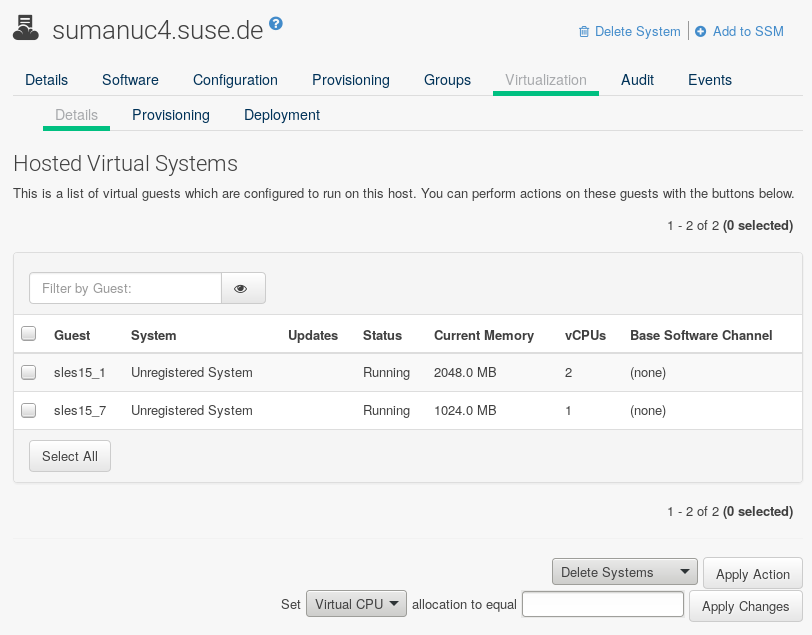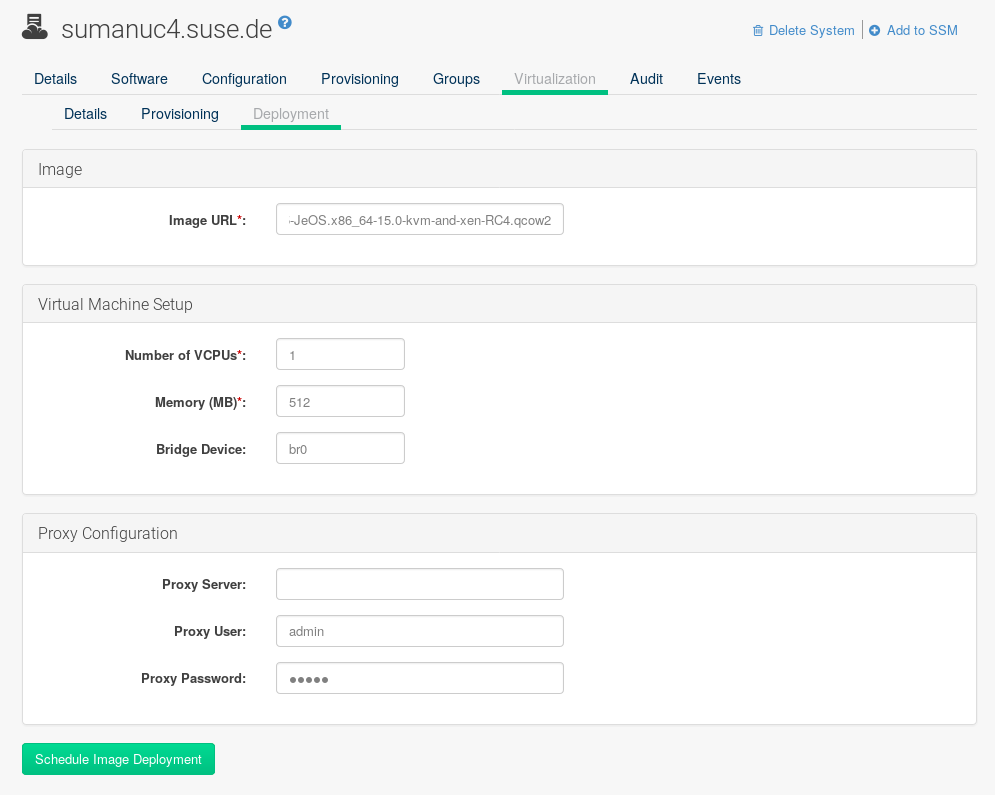SD Virtualization
This tab allows you to create new virtual guests, apply images on a traditionally managed host system, or change the status of virtual guests.

The Virtualization tab has one subtab, Guests.
For traditional systems that have Virtualization entitlements, you will also see two additional subtabs for Provisioning, and Deployment.
These tabs appear only for systems having the Virtualization entitlement.
It is not possible to create a guest system that runs on another guest system.
Guests
Guests is the default virtualization tab.
It presents a table of the host system’s virtual guests.
For each guest system, the following information is provided:
Status-
This field indicates whether the virtual system is running, paused, stopped, or has crashed.
Updates-
This field indicates whether patches (errata) applicable to the guest have yet to be applied.
Base Software Channel-
This field indicates the Base Channel to which the guest is subscribed.
|
If a guest system has not registered with SUSE Manager, this information appears as plain text in the table. |
Actions-
This field contains the possible actions for the guest. These are depending on the virtual guest status, they may not refresh instantaneously when running a Start, Stop, Suspend, Resume action. The Edit button allows changing virtual guest properties, including the amount of allocated memory and virtual CPUs.
The Graphical Console button opens the Spice or VNC display in a new tab.
If you have System Group Administrator responsibilities assigned for your guest systems, a user might see the message You do not have permission to access this system in the table.
This is because it is possible to assign virtual guests on a single host to multiple System Group Administrators.
Only users that have System Group Administrator privileges on the host system may create new virtual guests.
For Salt systems, the Create Guest button shows a dialog to configure and create a new virtual machine.
Editing a Virtual Machine
|
Traditional systems can only edit CPU and memory allocation. |
The fields in this dialog are grouped into several panels.
The General panel contains the CPU and memory fields.
The Disks and Network Interfaces panels list the fields corresponding to the matching devices of the virtal machine.
The Graphics panel allows configuring the display of the virtual machine.
The Schedule panel helps configuring when the edit should take place by choosing either an earliest time or an action chain to append to.
|
If a guest contains one or more disks or network interfaces not recognized by SUSE Manager, you will not be able to edit the configuration. This prevents any possibility of SUSE Manager destroying the setup because of an unhandled type. |
The order of the disks is important: the disk naming will be computed from it. This means that the first virtio disk will be named 'vda', the second will be named 'vdb' and so on.
When clicking the + in the Disks (or Network Interfaces) panel header, a new disk (or network interface) will be appended to the list.
Likewise, clicking the - button next to a disk or interface will remove it.
The default size for a new disk is 8[nbsp]GB.
The Source image template URL field contains the URL to a disk image to be copied and used for the virtual machine.
Click the Update button to apply the changes.
Creating a virtual machine [Salt]
To create a new virtual machine, the process is similar to editing, but there are some additional fields:
The Name field defining the name of the virtual machine to create.
The Hypervisor field to allow choosing among the available hypervisors of the host.
The Virtual Machine Type to choose between fully virtualized and para-virtualized virtual machines if applicable.
The Architecture to select the emulated CPU architecture, the default being the virtual host one.
By default a disk and a network interfaces are added. The only required value to set is the disk Source template image URL or the virtual machine will only have an empty disk.
The new virtual machine will start immediately after it has been defined.
Display a virtual machine graphical console [Salt]
The virtual machine graphical console might prompt you for a password. This password is the Spice or VNC one.
For the Spice display to be adjusted to the window, the Spice VD agent needs to be installed within the virtual machine.
Deployment [Management]
In the tab of a traditionally registered bare-metal machine, there is a subtab. This form expects a URL to a qcow2 type of image and some other parameters allowing the user to schedule the deployment of that image.

When the deploment scheduled it is listed as an action on the .